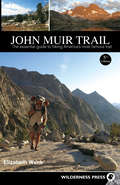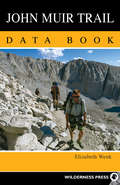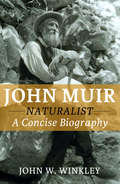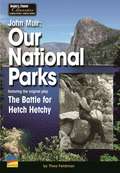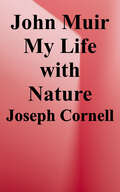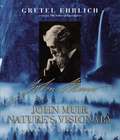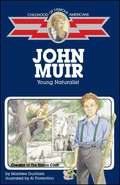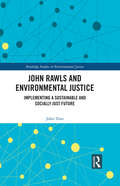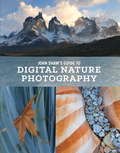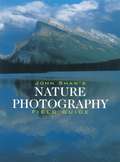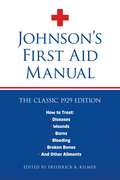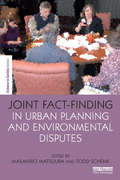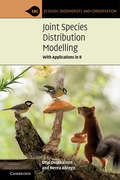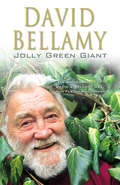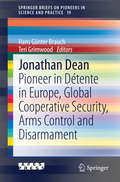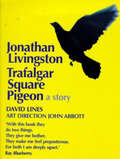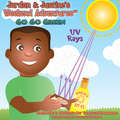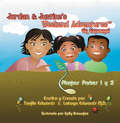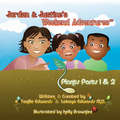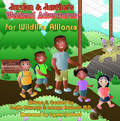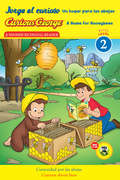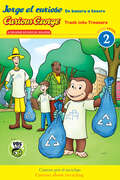- Table View
- List View
John Muir Trail
by Elizabeth WenkLizzy Wenk's authoritative guide John Muir Trail describes the 212-mile trail, running from Yosemite Valley to the summit of Mt. Whitney. It provides all necessary planning information, including up-to-date details on wilderness and permit regulations, food resupplies, trailhead amenities, and travel from nearby cities. Useful essentials are updated GPS coordinates and maps for prominent campsites (along with an updated list of sites along the trail), trail junctions, bear boxes, and other points of interest. The trail descriptions also include natural and human history to provide a workout for both body and mind -- a must-have for any Muir Trail enthusiast. Note that the text includes the southbound trail description, while the full guide with the northbound description is available as a separate ebook product.
John Muir Trail Data Book
by Elizabeth WenkA derivative of the comprehensive John Muir Trail by Sierra expert Elizabeth Wenk, this data book is perfect for the weight-conscious hiker. A brief introductory section provides planning data, including information on permits, trailhead transport, and food resupplies. This is followed by on-the-trail information, including custom-made topo maps, elevation profiles, data tables, and labeled panoramas from prominent passes. There are tables for trail junctions, nearly 300 campsites, ranger stations, food-storage lockers, and lateral trails accessing the JMT. For detailed information on planning for your trip, considerations for hiking in the Sierra Nevada, or a trail description, those are only available in the comprehensive John Muir Trail book.
John Muir: A Concise Biography of the Great Naturalist
by John W. WinkleyJohn Muir, Naturalist, first published in 1959, is an account of the life of John Muir (1838-1914) an early advocate of nature preservation. From his childhood in Scotland and the family’s move to Wisconsin, the book describes Muir’s early influences and his love of nature. After a time at the University of Wisconsin-Madison, and working in Indiana, Muir set off—on foot—to the Gulf of Mexico, and eventually ended in California, devoting time to the preservation of Yosemite and the western forests. In later life, Muir operated a large fruit farm in Martinez, California, while writing 12 books and over 300 articles, and co-founding the conservation organization the Sierra Club. Included are 6 pages of illustrations.
John Muir: Featuring the Original Play, The Battle for Hetch Hetchy (Readers Theater Classics)
by Thea FeldmanNIMAC-sourced textbook
John Muir: My Life With Nature (A Sharing Nature With Children Book)
by Joseph CornellA biography of the man known as "father of America's national parks" and an influential conservationist, told in the first person, using Muir's own words.
John Muir: Nature's Visionary
by Gretel EhrlichIn this definitive photobiography, Ehrlich brings her award-winning grace and insight to the life of one of our nation's most prized environmental heroes--John Muir, a founder of the Sierra Club.
John Muir: Young Naturalist (Childhood of Famous Americans Series)
by Montrew DunhamA founding father of the conservation movement in the United States, John Muir was born in Scotland and emigrated to Wisconsin when he was eleven. This easy-to-read fictionalized biography takes a look at Muir's life as young naturalist, destined to become one of America's first eco-heroes.
John Rawls and Environmental Justice: Implementing a Sustainable and Socially Just Future (Routledge Studies in Environmental Justice)
by John TönsUsing the principles of John Rawls’ theory of justice, this book offers an alternative political vision, one which describes a mode of governance that will enable communities to implement a sustainable and socially just future. Rawls described a theory of justice that not only describes the sort of society in which anyone would like to live but that any society can create a society based on just institutions. While philosophers have demonstrated that Rawls’s theory can provide a framework for the discussion of questions of environmental justice, the problem for many philosophical theories is that discussions of sustainable development open the need to address questions of ecological interdependence, historical inequality in past resource use and the recognition that we cannot afford to ignore the limitations of growth. These ideas do not fit in comfortably in standard discourse about theories of justice. In contrast, this book frames the discussion of global justice in terms of environmental sustainability. The author argues that these ideas can be used to develop a coherent political theory that reconciles cosmopolitan arguments and the non-cosmopolitan or nationalist arguments concerning social and environmental justice. This book will be of great interest to students and scholars of environmental philosophy and ethics, moral and political philosophy, global studies and sustainable development.
John Shaw's Guide to Digital Nature Photography
by John ShawPhotography legend John Shaw returns with his much-anticipated guide to digital nature photography, complete with more than 250 extraordinarily beautiful photographs. For over four decades, John Shaw&’s authentic voice and trusted advice has helped photographers achieve impressive shots in the great outdoors. In his first-ever book on digital photography, Shaw provides in-depth advice on everything from equipment and lenses to thorough coverage of digital topics including how to use the histogram. In addition, he offers inspirational and frank insight that goes far beyond the nuts and bolts of photography, explaining that successful photos come from having a vision, practicing, and then acquiring the equipment needed to accomplish the intention. Easily digestible and useful for every type of photographer, and complete with more than 250 jaw-dropping images, John Shaw&’s Guide to Digital Nature Photography is the one book you&’ll need to beautifully capture the world around you.
John Shaw's Nature Photography Field Guide
by John ShawAn updated bestseller, this book of extraordinarily beautiful photographs of nature contains state-of-the-art instruction on how any photographer can aim for equally impressive results every time a camera is focused on the great outdoors. Even highly skilled photographers are often baffled by the problems facing them when they work outdoors. But with this exceptional field guide in hand, every photographer--beginner, serious amateur, semi-pro, and pro--can conquer the problems encountered in the field. Using his own exceptional work as examples, the author discusses each type of nature subject and how to approach photographing it. Specific advice and information cover selection of equipment and lenses; how to compose a shot; how to get close ups; and other tips covering a range of techniques to enrich various types of nature photographs.From the Trade Paperback edition.
Johnson's First Aid Manual
by Frederick KilmerThe classic 1929 guide to first aid by a household name in America.
Joinery, Joists and Gender: A History of Woodworking for the 21st Century
by Deirdre VisserJoinery, Joists and Gender: A History of Woodworking for the 21st Century is the first publication of its kind to survey the long and rich histories of women and gender non-conforming persons who work in wood. Written for craft practitioners, design students, and readers interested in the intersections of gender and labor history—with 200 full-color images, both historical and contemporary—this book provides an accessible and insightful entry into the histories, practices, and lived experiences of women and nonbinary makers in woodworking. In the first half the author presents a woodworking history primarily in Europe and the United States that highlights the practical and philosophical issues that have marked women’s participation in the field. Research focuses on a diverse range of practitioners from Lady Yun to Adina White. This is followed by sixteen in-depth profiles of contemporary woodworkers, all of whom identify fine woodworking as their principal vocation. Through studio visits, interviews, and photographs of space and process, the book uncovers the varied practices and contributions these diverse artisans make to the understanding of wood as a medium to engage spatial, material, aesthetic, and even existential challenges. Beautifully illustrated profiles include Wendy Maruyama, one of the first women to earn an MFA in woodworking in the US; Sarah Marriage, founder of Baltimore’s A Workshop of Our Own, a woodshop and educational space specifically for women and gender non-conforming makers; Yuri Kobayashi, whose sublime work blurs boundaries between the worlds of art and craft, sculpture, and furniture; and Folayemi Wilson, whose work draws equally on African American history and Afrofuturism to explore and illuminate the ways that furniture and wood traditions shape social relations.
Joint Fact-Finding in Urban Planning and Environmental Disputes (The Earthscan Science in Society Series)
by Masahiro Matsuura and Todd SchenkThe days of rationalist scientific management and deference to official data are behind us. The credibility of experts and the information they provide are regularly challenged; officials are routinely provided with conflicting sets of facts as they plan and make decisions; and decision makers and stakeholders alike are largely skeptical that technical information will adequately account for the various interests and concerns and lead to the right outcomes. They struggle to reconcile technical information with other forms of knowledge, and differing interests, priorities and perspectives. Issues like climate change are complicating matters even further, as scientists and technicians must increasingly acknowledge the uncertainty and potential fallibility of their findings, and highlight the dynamic nature of the systems they are explaining. This book examines how groups looking to plan and make decisions in any number of areas can wade through the imperfect and often contradictory information they have to make fair, efficient, wise and well-informed choices. It introduces an emerging and very promising approach called joint fact-finding (JFF). Rather than each stakeholder group marshaling the set of facts that best advance their respective interests and perspectives while discrediting the contradictory facts others provide, groups are challenged to collaboratively generate shared sets of facts that all parties accept. This book introduces readers to the theory of JFF, the value it can provide, and how they can adopt this approach in practice. It brings together writings from leading practitioners and scholars from around the world that are at the forefront of the JFF approach to science intensive policymaking, urban planning, and environmental dispute resolution. The first set of chapters outlines the concept of JFF, and situates it within other bodies of theory and practice. The second set of case-based chapters elucidates how JFF is being applied in practice. This book delivers a new perspective to scholars in the field of public policy, urban planning, environmental studies, and science and technology studies, as well as public officials, technical experts, policy consultants, and professional facilitators.
Joint Species Distribution Modelling: With Applications in R (Ecology, Biodiversity and Conservation)
by Otso Ovaskainen Nerea AbregoJoint species distribution modelling (JSDM) is a fast-developing field and promises to revolutionise how data on ecological communities are analysed and interpreted. Written for both readers with a limited statistical background, and those with statistical expertise, this book provides a comprehensive account of JSDM. It enables readers to integrate data on species abundances, environmental covariates, species traits, phylogenetic relationships, and the spatio-temporal context in which the data have been acquired. Step-by-step coverage of the full technical detail of statistical methods is provided, as well as advice on interpreting results of statistical analyses in the broader context of modern community ecology theory. With the advantage of numerous example R-scripts, this is an ideal guide to help graduate students and researchers learn how to conduct and interpret statistical analyses in practice with the R-package Hmsc, providing a fast starting point for applying joint species distribution modelling to their own data.
Jolly Green Giant
by David BellamyDavid Bellamy is a natural story teller whose memoir will be packed full of funny anecdotes and observations. It is the story of how a city boy, brought up in the middle of London, went for a trip into the countryside one day, an event which was to transform his life by setting in motion the amazing love of nature which would make famous this larger-than-life character. In his infectious style he illumines on, amongst other things, the fact that his father, the manager of a branch of Boots, had to grease his hair straight - because in those days managers of Boots weren't allowed to have curly hair! Then there was the time he and his brother discovered an exploded bomb, kept in the garden shed - and then accidentally blew off the front of the house with it. He reveals his secret passion is ballet dancing - and how his mother only found out about it when she saw him on stage at the Fairfield Hall in Croydon. His career as an academic, then author, broadcaster, consultant and television personality, spans 35 years and his main passion - campaigning for the environment - have led to many adventures including his being twice imprisoned in the Third World.
Jonathan Dean
by Hans Günter Brauch Teri GrimwoodJonathan Dean (1924-2014) was a distinguished U. S. diplomat (1950-1980) and from 1984 to 2007 global security adviser to the Union of Concerned Scientists, Washington, D. C. During the 1980s and 1990s he was a pioneering conceptual thinker, writer and speaker on détente in Europe, global cooperative security, arms control and disarmament. He authored: Watershed in Europe (1987), Meeting Gorbachev's Challenge (1989) and Ending Europe's Wars (1994). This volume contains his biography and bibliography, six texts on détente and arms control in Europe in the 1980s: Beyond First Use; MBFR; Alternative Defence; Berlin; A Crisis Management Center; Conventional Arms Control in Europe and six texts on the new security order in Europe since the 1990s: Components of a Post-Cold War Security System for Europe; Constraining Technological Weapons Innovation; NATO Enlargement: Act II; Ten Years after the Wall; Future Security in Space; Rethinking Security: Return to the Grotean Pattern.
Jonathan Livingston Trafalgar Square Pigeon
by David LinesContinuing the tradition of parodying all things sacred, the author of The XXXX Files and PMT takes up the reigns of satire by rewriting the essential 1970s hippy handbook Jonathan Livingston Seagull. Instead of a seagull for a hero, this updated classic features a bloated, cynical, grungy pigeon, who looks not to the skies for inspiration, but to the London Underground. Cutting corners wherever possible and living the life of a fully fledged MTV-generation feral pigeon, Jonathan's rite of passage is more a celebration of modern-day teenage apathy set against a backdrop of 90s Pop Culture and Victorian underground architecture than a voyage of delicious self-discovery. Matching the original page-for-page in content and layout, Jonathan Livingston Trafalgar Square Pigeon is a modern-day morality tale that will, by its very nature, attract plenty of attention whilst ever so gently ruffling a few feathers along the way.
Jordan & Justine's Weekend Adventures: Go Go Green
by Tanille EdwardsJordan & Justine's Weekend AdventuresTM: Go Go Green takes children on an exciting, high-flying adventure as they learn to go green. Jordan and Justine are part of a Go Go Green campaign in their community, and they teach young readers about the environment, how to take steps to save energy, how to participate in their community, and why it is important to care about the earth! The multicultural cast of characters in this book explore how Native American culture uses the environment for resources and how modern living affects the environment. Children will also learn new words in Spanish. Also look for Jordan & Justine's Weekend Adventures: Wildlife Parts 1 & 2, ISBN: 978-0-9787302-4-6 & Jordan & Justine's Weekend Adventures: Plants Parts 1 & 2, ISBN: 978-0-9787302-4-6
Jordan & Justine's Weekend Adventures: Plantas Partes 1 & 2
by Tanille Edwards Latoya EdwardsJordan & Justine's Weekend Adventures: Plantas Partes 1 y 2 es una gira educacional explorando el crecimiento de las plantas, la historia del maní, saludables hábitos de comida, fotosíntesis y relaciones familiares. Jordan & Justine's Weekend AdventuresT: Plantas Partes 1 y 2 is an educational ride exploring plant growth, the history of peanuts, healthy eating habits, photosynthesis and family relationships.
Jordan & Justine's Weekend Adventures: Plants Parts 1 & 2
by Tanille Edwards Latoya EdwardsJordan & Justine's Weekend Adventures: Plants Parts 1 & 2 is an exciting educational ride exploring plant growth, the history of peanuts, healthy eating habits, photosynthesis and family relationships. Jordan and Justine start out by helping their mother in her garden one Saturday morning to plant pumpkin seeds. From there, the brother and sister pair learn how seeds sprout into plants, the health benefits of pumpkins, the history of peanuts, how to research on the internet and then they use their magical powers to get an up close look at photosynthesis. Jordan and Justine's Weekend Adventures inspire children to learn about science, to love their families, to be confident and to use their imaginations!
Jordan & Justine's Weekend Adventures: Wildlife Parts 1 & 2
by Tanille Edwards Latoya EdwardsJordan & Justine's Weekend AdventuresTM: Wildlife Parts 1 & 2 brings children right into the center of animal life at a wildlife conservation center. The brother and sister pair, Jordan & Justine, and their two friends, Raj and Ling, learn how koalas live, what it means when an animal is said to be endangered, and how humans can help. Jordan and Justine use their magical powers to explore the world of dolphins, to find out how laws can protect wildlife, and to learn what it means to be a mammal. Perfect for children ages 7 to 9. Also look for Jordan & Justine's Weekend AdventuresTM: Plants Parts 1 & 2, ISBN: 978-0-9787302-4-6, at your local bookstore or online at retailers everywhere. Children love to explore plant growth, healthy eating habits, and photosynthesis with Jordan and Justine in this fun book!
Jorge el curioso Un hogar para las abejas/Curious George A Home for Honeybees: (CGTV Reader) (Curious George)
by H. A. ReyIn this Spanish/English bilingual reader, based on the Emmy Award–winning PBS TV show, Curious George and his friend Steve find themselves in a sticky situation when they accidentally eat all of Betsy's delicious honeycomb for her Earth Day presentation about bees. How will they get more before Betsy finds out? This readers includes tons of information about bees and two activities that reinforce the concepts in the story. <p><p> En la presente edición bilingüe inglés-español, basada en el programa de televisión Curious George, galardonado con el premio Emmy y emitido por la cadena PBS, Jorge el Curioso y su amigo Steve se ven en una situación pegajosa cuando por accidente se comen todo el panal delicioso que Betsy tenía preparado para una presentación sobre las abejas el Día de la Tierra. ¿Cómo conseguirán otro para que Betsy no se entere? Esta lectura incluye muchísima información sobre las abejas y dos actividades para reforzar los conceptos presentados en el cuento.
Jorge el curioso siembra una semilla/Curious George Plants a Seed: (CGTV Reader) (Curious George)
by H. A. ReyCurious George watches Jumpy the squirrel bury an acorn in the yard. Upon learning that Jumpy is storing food for later, George decides to do the same. The man with the yellow hat comes home to find the kitchen empty and its contents buried in the yard! It's time to teach George about what things grow and what don't. George finally gets it right when he grows a beautiful sunflower from a seed. This edition features English and Spanish text, set in different colors for easy readability. <p><p> Jorge el curioso observa a la ardilla Saltarina enterrar una bellota en el jardín. Al enterarse de que Saltarina está almacenando comida para más tarde, Jorge decide hacer lo mismo. Cuando el hombre del sombrero amarillo vuelve a casa, encuentra la cocina vacía... ¡y toda la comida enterrada en el jardín! Es hora de enseñarle a Jorge qué cosas crecen y cuáles no. Finalmente, Jorge lo entiende cuando siembra una semilla y ve crecer un hermoso girasol.
Jorge el curioso: (CGTV Bilingual Reader) (Curious George)
by H. A. ReyJorge el curioso es parte de un desafío de equipo para limpiar las calles de la ciudad, ¡hasta que encuentra tesoros escondidos en el camino! Jorge es parte de un desafío de equipo para ayudar a limpiar la ciudad en el Día de la Ciudad Bonita. Pero cuando encuentra tesoros escondidos y olvidados en el camino, se da cuenta de que está recolectando más tesoros que basura. Si quiere ayudar a su equipo a ganar el desafío, tendrá que resolver su creciente alijo de tesoros y ver cuáles realmente quiere conservar. ¿Pero cómo? También incluye actividades de bonificación para ayudar a reforzar los conceptos presentados en la historia.In this bilingual Green Light Reader based on Curious George, the Emmy Award-winning PBS TV show, George is ready to help clean up the city. But George quickly finds that someone else's trash could be his treasure! George is part of a team challenge to help clean up the city on Pretty City Day. But when he finds hidden and forgotten treasures along the way, he realizes he's collecting more treasures than he is trash! If he wants to help his team win the challenge, he'll need to sort out his growing stash of treasures and see which ones he really wants to keep. This Spanish/English bilingual reader is set in two different color text for ease of readability, and also includes bonus activities to help reinforce the concepts presented in the story.
